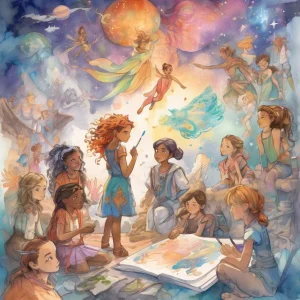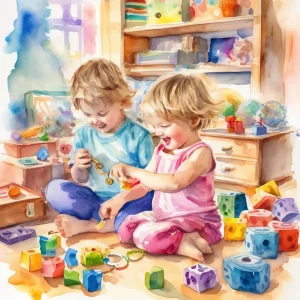Activity
Similar Activities
Enchanted Digital Storytelling Adventure through Nature's Wonders
Children’s Age: 5–18 years
Activity Duration: 50 minutes
Let's go on a "Digital Storytelling Adventure"! We'll create exciting stories using nature-themed digital images and fun drawing tools on a tablet or computer. Get ready to brainst…
Activity Duration: 50 minutes
Emotion Explorers: Storytelling with Feelings Adventure
Children’s Age: 2–3 years
Activity Duration: 5 – 15 minutes
"Storytelling with Feelings" is designed for children aged 24 to 36 months to enhance their communication skills, empathy, and language development by exploring emotions in stories…
Activity Duration: 5 – 15 minutes
Sensory Treasure Hunt: A Magical Exploration Journey
Children’s Age: 0 month – 6 years
Activity Duration: 10 minutes
Let's go on a Sensory Treasure Hunt! We will use our senses to explore different items like textures, scents, and sounds. You can feel, smell, and listen to each item while blindfo…
Activity Duration: 10 minutes
Empathy Tales: Digital Storytelling Journey
Children’s Age: 6–10 years
Activity Duration: 15 minutes
"Digital Storytelling with Empathy" is a creative activity for children aged 6 to 10, focusing on empathy, self-regulation, and language skills using digital tools. With a tablet o…
Activity Duration: 15 minutes
Nature's Touch: Sensory Nature Exploration for Babies
Children’s Age: 3 – 9 months
Activity Duration: 5 – 10 minutes
Engage your 3 to 9-month-old baby in a sensory nature exploration activity to support their development. Lay them on a soft blanket with safe natural objects and optional toys. Des…
Activity Duration: 5 – 10 minutes
Enchanted Storybook Illustration Adventure
Children’s Age: 6–10 years
Activity Duration: 25 minutes
Engage children aged 6 to 10 in the "Storybook Illustration Adventure" for a creative and language-rich experience. Gather drawing materials and set up individual workspaces to ill…
Activity Duration: 25 minutes
Nature's Tongues: Exploring Nature in Different Languages
Children’s Age: 4–6 years
Activity Duration: 15 – 20 minutes
Explore Nature in Different Languages is an engaging activity that boosts children's language and academic skills by immersing them in nature through multiple languages. Children w…
Activity Duration: 15 – 20 minutes
Enchanted Puzzle Quest: Teamwork Puzzle Challenge
Children’s Age: 7–9 years
Activity Duration: 40 – 45 minutes
The "Teamwork Puzzle Challenge" activity is designed to boost moral development, teamwork, problem-solving, and communication skills in children. You'll need age-appropriate puzzle…
Activity Duration: 40 – 45 minutes
Ecosystem Adventure Board Game - Nature's Quest
Children’s Age: 7–9 years
Activity Duration: 10 – 25 minutes
An interactive board game where children explore and learn about ecosystems through challenges and tasks.
Activity Duration: 10 – 25 minutes
Sensory Sound Box Exploration: A Musical Adventure
Children’s Age: 1–1.5 years
Activity Duration: 5 – 20 minutes
An engaging activity involving sensory exploration of sound using a variety of household items.
Activity Duration: 5 – 20 minutes
Musical Freeze Painting: A Creative Dance Adventure
Children’s Age: 3 years
Activity Duration: 10 – 20 minutes
An engaging activity combining painting with musical freeze dance to promote creativity and play skills.
Activity Duration: 10 – 20 minutes
Sensory Music-Making Session: Sound Story Drawing Adventure
Children’s Age: 2–2.5 years
Activity Duration: 5 – 20 minutes
A sensory music-making activity using household items to enhance sensory development and introduce children to the world of music.
Activity Duration: 5 – 20 minutes


























